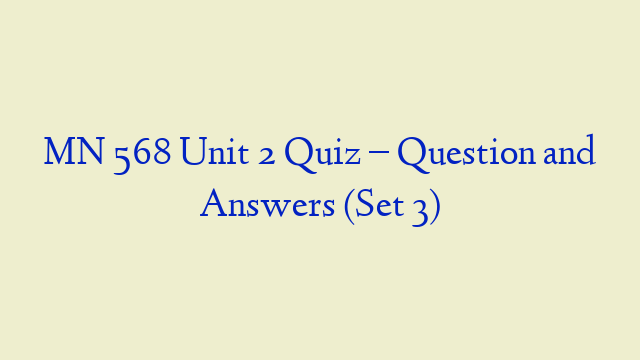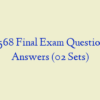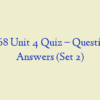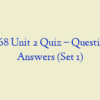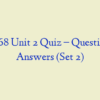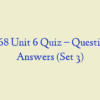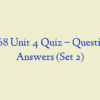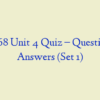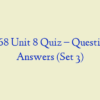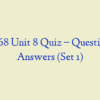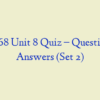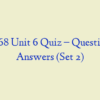Description
MN 568 Unit 2 Quiz
- Which of the following antibiotics provides the best coverage in acute or chronic sinusitis when gram-negative organisms are suspected?
- A 65-year-old man presents to the clinician with complaints of increasing bilateral peripheral vision loss, poor night vision, and frequent prescription changes that started 6 months previously. Recently, he has also been seeing halos around lights. The clinician suspects chronic open-angle glaucoma. Which of the following statements is true concerning the diagnosis of chronic open-angle glaucoma?
- Joyce is taking a long-acting beta-agonist for her asthma. What additional medication should she be taking?
- You are in the park playing with your children when you see that your friend is screaming for help. Her toddler has fallen and there is a stick lodged in his eye. The child is kicking and screaming and grabbing for the stick. You:
- A patient presents with the following signs and symptoms: gradual onset of low-grade fever, marked fatigue, severe sore throat, and posterior cervical lymphadenopathy. Based on the signs and symptoms alone, which of the following conditions is most likely the cause?
- Which of the following is an example of sensorineural hearing loss?
- Which of the following statements regarding pulmonary function is true?
- Which of the following statements regarding TST is true?
- A patient presents to the clinician complaining of ear pain. On examination, the clinician finds that the patient has tenderness on traction of the pinna as well as when applying pressure over the tragus. These findings are classic signs of which condition?
- An acutely presenting, erythematous, tender lump within the eyelid is called:
- Fluctuations and reductions in estrogen may be a contributing factor in which type of rhinitis?
- Most nosocomial pneumonias are caused by:
- You are doing a cerumen extraction and touch the external meatus of your patient’s ear. He winces and starts coughing. What is the name of this reflex?
- Sinusitis is considered chronic when there are episodes of prolonged inflammation with repeated or inadequately treated acute infection lasting greater than:
- As diabetic retinopathy progresses, the presence of ‘cotton wool’ spots can be detected. Cotton wool spots refer to:
- Which immunoglobulin mediates the type 1 hypersensitivity reaction involved in allergic rhinitis?
- Cydney presents with a history of asthma. She has not been treated for a while. She complains of daily but not continual symptoms, greater than 1 week and at nighttime. She has been using her rescue inhaler. Her FEV1 is 60% to 80% predicted. How would you classify her asthma severity?
- Acute angle-closure glaucoma involves a sudden severe rise in intraocular pressure. Which of the following ranges represents normal intraocular pressure?
- What is the first-line recommended treatment against Group A ?-hemolytic streptococci (GABHS), the most common cause of bacterial pharyngitis?
- Which type of stomatitis results in necrotic ulceration of the oral mucous membranes?
- Your patient states he has a strep throat infection. Which of the following symptoms makes you consider a viral etiology instead?
- The clinician is assessing a patient complaining of hearing loss. The clinician places a tuning fork over the patient’s mastoid process, and when the sound fades away, the fork is placed without restriking it over the external auditory meatus. The patient is asked to let the clinician know when the sound fades away. This is an example of which type of test?
- A patient presents to the clinician with a sore throat, fever of 100.7?F, and tender anterior cervical lymphadenopathy. The clinician suspects strep throat and performs a rapid strep test that is negative. What would the next step be?
- Which information should be included when you are teaching your patient about the use of nicotine gum?
- Which of the following conditions is associated with cigarette smoking?
- The presence of hairy leukoplakia in a person with no other symptoms of immune suppression is strongly suggestive of which type of infection?
- Which subtype of cataracts is characterized by significant nearsightedness and a slow indolent course?
- Julie has a postnasal drip along with her cough. You assess her for:
- Otitis media is considered chronic when:
- Which of the following statements is true concerning the use of bilberry as a complementary therapy for cataracts?
- Nathan, a 32-year-old policeman, has a 15-pack-a-year history of smoking and continues to smoke heavily. During every visit, he gets irate when you try to talk to him about quitting. What should you do?
- Patients with acute otitis media should be referred to a specialist in which of the following situations?
- A patient with hypertension comes in and insists that one of his new medications is causing him to cough. When looking at his list of medications, you think the cough must be from:
- In which of the following situations would refer to a specialist be needed for sinusitis?
- The clinician is seeing a patient complaining of red eye. The clinician suspects conjunctivitis. The presence of mucopurulent discharge suggests which type of conjunctivitis?
- You are using the CURB-65 clinical prediction tool to decide whether Mabel, whom you have diagnosed with community-acquired pneumonia (CAP), should be hospitalized or treated at home. Her score is 3. What should you do?
- Jason, age 62, has obstructive sleep apnea. What do you think is one of his contributing factors?
- Jolene has breast cancer that has been staged as T1, N0, M0. What might this mean?
- Your patient is on Therabid for his asthma. You want to maintain his serum levels between:
- Marta is taking TB drugs prophylactically. How do you instruct her to take them?
- You have a patient who is positive for Strep on rapid antigen testing (rapid strep test). You order amoxicillin after checking for drug allergies (patient is negative) but he returns 3 days later, reporting that his temperature has gone up, not down (101.5 F in office). You also note significant adenopathy, most notably in the posterior and anterior cervical chains, some hepatomegaly, and a diffuse rash. You decide:
- A chronic cough lasts longer than:
- Supplemental oxygen for how many hours per day has been shown to improve the mortality associated with COPD?
- The most significant precipitating event leading to otitis media with effusion is:
- African American patients seem to have a negative reaction to which of the following asthma medications?
- Why do you suspect that your patient may have a decreased response to the tuberculin skin test (TBT)?
- Which of the following medications used in the treatment of glaucoma works by constricting the pupils to open the angle and allow aqueous fluid to escape?
- Which ethnic group has the highest lung cancer incidence and mortality rates?
- The barrel chest characteristic of emphysema is a result of:
- The most common cause of CAP is?
